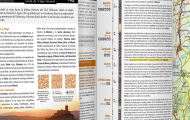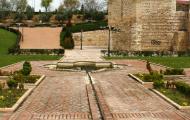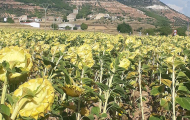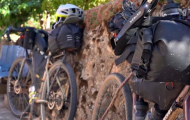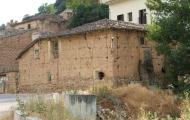The Álvar Fáñez route by Gravel Bike
GUADALAJARA
The Álvar Fáñez gravel route: Álvar Fáñez’s surprise attack through the Henares basin
- Route: From Villaseca de Henares or from Castejón de Henares (Guadalajara) to Guadalajara.
- Provinces: Guadalajara
- Kilometres: approx. 70 km
- Recommended days: 1 day
- Difficulty: Low
Information you can download on this page
- The PDF guide for gravel (contains detailed maps).
- The list of accommodation.
- The list of points of issue and stamping of the laissez-passer.
- The list of tourist offices.
- The tourist brochure (which you can request at any of the tourist offices along the route).
- The cycling tracks of the route in gpx, kmz and trk format.
Remember that you can get more information about each route for free at the Camino del Cid Tourist Offices: including brochures and the safe-conduct.
Download our travel app free of charge
We recommend you download our mobile travel app, available on iOS and Android. The app contains all our routes, you'll never get lost and you'll find information on 4,500 geo-referenced points (Cidian enclaves, places to see, accommodation, pass stamping points, etc.).
The app is free, updated daily and does not require registration. It also works in environments without coverage, so during installation and when you first turn it on, depending on your connection, it may take a few minutes to get it up and running, so be patient, it's worth it!

The Plot: plundering the River Henares basin
This branch route commemorates the famous raid or surprise attack of Álvar Fáñez. According to the Poem, whilst El Cid was laying siege to Castejón, his loyal vassal, accompanied by two hundred knights, plundered the banks of the River Henares, passing through Hita and Guadalajara as far as the gates of Alcalá de Henares. He returned with “herds of cattle and flocks of sheep” and “great quantities of other riches” to provide provisions for El Cid’s needy troops, who immediately set off in a north-easterly direction, heading for Zaragoza via Anguita.
The journey
This small branch route takes us through small towns and villages as far as Guadalajara. It is a relatively easy route through the meadows that line the River Badiel, dotted with areas of scrubland and cereal crops. It is also scattered with modest examples of rural Romanesque architecture in Villaseca de Henares, Utande and Muduex. Halfway along the route, the walled town of Hita nestles beneath its imposing castle, evidence of its twofold nature as a monumental town (it has been declared a historic and artistic site) and its literary connections (it is mentioned in the Song of El Cid and is the birthplace of Arcipreste de Hita).
The route continues as far as Guadalajara, an Arabic name meaning ‘river of stones’. Guadalajara was originally an Andalusian military post close to the Duero boundary. Many of the armies marching from Toledo passed through this point before continuing on their way to Atienza or Medinaceli. Although its landmark monument is the Palace of El Infantado (15th – 16th centuries), it is also home to many medieval monuments such as the bridge built during the caliphate (although few traces remain of the original 10th century construction, as it was rebuilt in the 18th century), several interesting examples of Mudejar architecture and the towers of Alamín and Álvar Fáñez (dating back to the 13th and 14th centuries).
Signposting and condition of the route
- If you are going to travel, we recommend our map viewer:the Route Alerts box shows you the most important incidents you may encounter on the road: high vegetation, interrupted crossings, road works, fallen or missing signs and any other obstacle you need to be warned about..
Tips and recommendations
- Travel safely and unhurriedly: take the tracks and route guide with you. The route is signposted and we do maintenance on the signs every year; however, signs can also disappear (by accident, the weather, vandalism) and, in that case, especially when you are in the mountains, the track and route guide become very important. The route guide also indicates the levels of difficulty of each section and it is a good idea to check it out before starting each stage. The main problem as far as getting lost is concerned comes in the villages: although we have placed signposts in many of them, we have not covered all of them and, even in those with signposts, you might not see the marks and not find the exit easily. Of course, it is best to ask a local and take the tracks and route guide with you, since they contain the indications you need to follow the route.
- Food and spares. One of the main advantages of the Way of El Cid is that it runs through very attractive places with few inhabitants: many of the villages are very small and they do not have food stores. Unless you have planned to eat in a bar or restaurant, it is very important to take some food with you (sandwiches, nuts, energy bars, etc.) in case you can't find anywhere to eat or buy food. Also remember to take water with you. In most of the villages, there are drinking fountains: remember to refill your water bottles before setting off again. The same applies for spare parts: remember to take a repair kit with you and the more complete it is, the greater your peace of mind will be. Welcome to the Middle Ages.
- Book your accommodation in advance. You are about to travel through one of the areas with the lowest population density in Europe. Some villages are very small and have limited infrastructures. Book your accommodation at the end of the stage in advance and if you change where you plan to finish the route, check that there is accommodation available there.
- Check our cartographic viewer: the Alerts on Route shows you the most important incidents you can find on the way: tall vegetation, interrupted steps, road works, fallen or missing signs and any other obstacle from which you need to be warned about.
- Don't forget your helmet: it is compulsory for adults to wear helmets on roads outside cities and for under 16s it is compulsory at all times.
- Get your Letter of safe conduct. The Letter of Safe Conduct is a personalised 'passport' you can have stamped at many towns and villages on the Way of El Cid.
- Your literary guide. You might think it's unnecessary weight, but for many it is essential: don't forget to take with you a copy of the Poem of The Cid; you will be able to recreate some of its passages on site.
- And, of course, respect the signs you come across: damaging, knocking down or changing a sign means that those behind you might get lost.
Rev. ALC: 29.01.18


